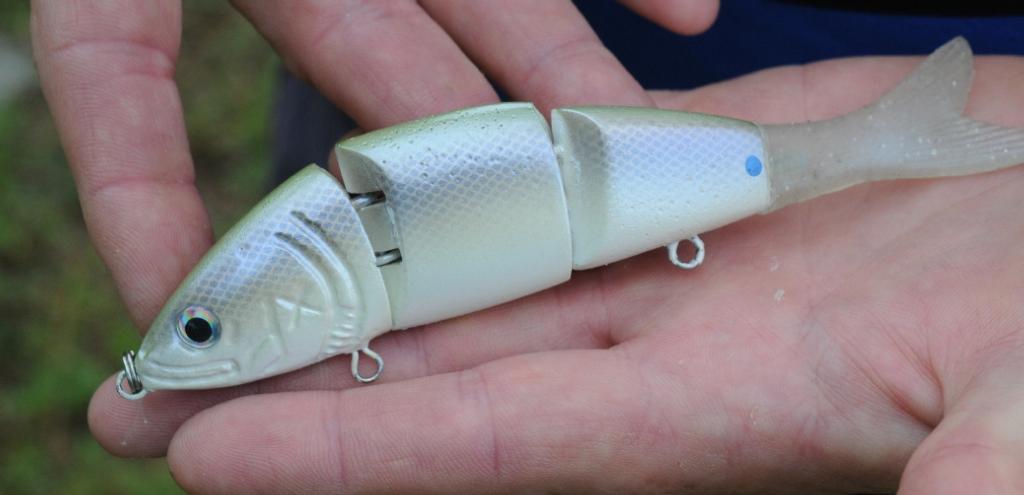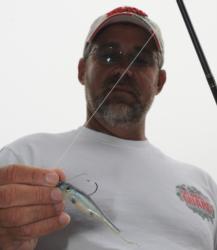Blueback maniacs
Blueback herring to be supporting cast at Forrest Wood Cup

GAINESVILLE, Ga. – How much have blueback herring changed the face of fishing at Lake Lanier? We are about to find out as 78 of the world’s best bass pros probe the northern Georgia lake in search of the biggest bass they can find in an effort to win the Forrest Wood Cup and the potential $600,000 payday that goes with it.
It’s been a while since Lanier has had a major national bass tournament on its waters, and the Forrest Wood Cup marks the first time the lake has ever hosted a championship event where the best of the best compete for a top payout of at least $500,000.
The result is having the best talent in bass fishing evaluate the lake to harness its optimum potential as a fishery. Competition is fierce, and qualifiers have done everything possible to gain an edge.
The combined amount of time, energy and expense these pros have spent in preparation for this event is immeasurable.
Not only are there a few of the best local pros in the event, but you can bet that many of the other top sticks on Lanier have pointed pros in the right direction during the pre-practice period.
The byproduct of this fierce competition is the sheer amount of information that will come out of Lanier’s waters over the next few days as the best pros show their hands and reveal the lures, patterns, tactics, techniques and areas they have spent so much time acquiring.
Much of that information will center on the mysterious relationship between blueback herring and spotted bass, especially in the summertime.
In short, spotted bass love to eat blueback herring – mystery solved, right?
Well, it’s not quite that simple. Yes, spotted bass do love blueback herring, so much so that many anglers contend bluebacks have actually altered the behavior of spotted bass, specifically the big ones.
Once upon a time, spotted bass in Lake Lanier made a living off of small shad and the result were rail-thin bass. A limit of keepers totaled up to about 7 pounds, and a really big spot tipped the scales at 3 pounds.
Then the blueback herring arrived. Put another way, spotted bass had been surviving off of lettuce sandwiches (no offense to shad), and then Hardee’s Monster Thickburgers showed up in abundance and the spots couldn’t push away from the table.

As Lanier’s spotted bass began to loosen their belts past the 3-pound mark, then past the 4-pound mark and toward the 5-pound territory, Lanier bass anglers were wrought with excitement. And the best part: Many times these now monstrous spotted bass slurped their “thickburgers” right off the surface with mind-blowing topwater strikes.
But then came the caveat: By nature, bluebacks were true nomads. Unlike shad, which would ball up around deep brush and under the dark shade of docks for protection, blueback herring roamed the open waters without direction or respite – they swam, and they swam, and they swam.
Once big spotted bass had become addicted to the protein rush of bluebacks, they couldn’t quit eating them. As a result, spotted bass themselves have become open-water roamers, now conditioned to swim freely like striped bass – with no connection or orientation to cover – in an effort to keep eating bluebacks.
“It’s an odd catch-22 that kind of feeds on itself,” explained Tom Mann Jr., the Cup’s local favorite, who has been fishing Lanier for 40 years and has watched the transformation take place. “The more the spots feed on bluebacks, the bigger they get. And the bigger they get, the more they follow the bluebacks. And the more they follow the bluebacks, the more free-roaming they become. And the more they roam out in the middle of nowhere, the harder they are to pin down.”
Another local, Jason Meninger of Gainesville, Ga., believes that once a spotted bass reaches about 2 1/2 pounds, it gets off the shad diet and heads for the blueback feeding grounds, located somewhere in the middle of the lake over many fathoms of water.
“You can still catch plenty of spots up around docks and shallower brush,” Meninger said. “But this time of year, they’re seldom over 2 1/2 pounds; it’s like they hit the size ceiling. Yet when you get on one of those open-water schools out in the middle of the lake, they’re seldom smaller than 3 pounds. And I’m convinced there are spotted bass out there that have never seen a lure.”
Tim Farley of Lula, Ga., won the FLW Series event on Lanier in 2006. Farley is not fishing the Cup this week, but is a respected local angler when it comes to winning tournaments on Lanier.
He believes spotted bass must actually reach a certain physical size, not just to eat bluebacks, but to avoid being eaten as well.
“If a little 12- or 13-inch spotted bass gets out there and tries to run with those bluebacks, a big striper would eat him up,” Farley said. “Those big stripers chase the bluebacks too, and they’ll eat anything that gets in their way. So a spotted bass has got to be near that 3-pound class to run around out there with those stripers and bluebacks and not be mistaken for food.”
Farley is so infatuated with bluebacks, he’s gone to extensive lengths to build lures that perfectly mimic them. He even went so far as to freeze bluebacks and design baits that are their exact size and color. The result is Farley’s Pro-X swimbait (lead photo).
Former FWC winner Scott Suggs is a master at catching suspended spotted bass on his home waters in Arkansas. But he says Lanier spotted bass that chase bluebacks are a different breed.
“These spots don’t really `hang up’ and stay on structure like ours do,” Suggs said. “I’ve found some of the most beautiful structure spots out here with some of the prettiest pieces of standing timber I’ve ever seen, but they’re empty. Back home our fish sit in places like that and wait for the shad to come to them. But here, these fish don’t sit still; they’re always chasing those darn bluebacks.”
Renegade patterns
Although all the pretournament talk is about bluebacks and big spots, there are other ways to catch bass on Lanier and some overlooked, renegade pattern could surface over the next few days.
At the 2008 Forrest Wood Cup at Lake Murray, pretournament talk centered on catching bass from Murray’s deeper haunts. Many figured deep-water bass would be the ticket to win.
But on the day off between practice and competition, dark skies and an all-day rain cooled Murray’s surface temps significantly.
Four days later, Western pro Michael Bennett claimed victory by fishing a floating frog in a foot of water, far away from Murray’s depths where a win was predicted.
At Pittsburgh in 2009, the Forrest Wood Cup was billed by some anglers as the “Fairy Wand Cup,” given the amount of finesse and spinning-rod tactics that would be required to win. Limits weighing 6 or 7 pounds were considered “monster” bags.
But copious amounts of rain before the event produced large slugs of water and current through the Three Rivers system during the event. Pro Greg Hackney tied on regular-sized crankbaits and spinnerbaits and power-fished like he was on the Potomac River. On day two, he caught a mind-warping 11-pound, 12-ounce limit to jump into the lead, and he never checked up until he got to victory lane.
One significant weather or condition change can yield a renegade pattern that few considered, allowing the pro who taps into it to run away with the tournament.
As this report is being written, a seven-day heat wave of 93- to 97-degree temperatures in Atlanta is being broken. On Monday, temperatures barely topped the 75-degree mark in Gainesville. Some pros even reported wearing jackets much of the practice day. And on Tuesday morning, thundershowers rained down on Lanier for a couple of hours.
As a result, surface temperatures on Lanier have dropped 6 to 7 degrees, perhaps opening the door for a renegade pattern.
West again in 2010?
Western anglers have proven their might in the Forrest Wood Cup, especially in even years. In 2004 Washington state native Luke Clausen won. In 2006, California pro Brent Ehrler took the top honors. And in 2008, Western-born Michael Bennett ruled Lake Murray.
Last year, Western pros Rusty Salewske and Cody Meyer gave Hackney a run for the money in Pittsburgh.
Will the West win again in 2010? There’s a pretty good chance since 25 of the pros in the Forrest Wood Cup have Western roots. Plus, Lake Lanier’s clear water and spotted bass are going to make some Western pros feel right at home.
Most of all, though, what the West brings to the table are tricked-out techniques and innovative tactics for fooling bass.
There’s no denying that the Western ways of catching bass have greatly influenced Eastern techniques – from shaky heads to drop-shots to swimbaits. Perhaps a completely new lure devised in a Western pro’s basement will be broken out this week.
In fact, Tim Farley’s blueback herring look-a-like is a jointed, multi-segmented swimbait like the ones that have been popularized in the West, proving that bass-fishing innovation is a coast-to-coast obsession, especially when big championship purses are on the line.